Large-scale quantitative LC-MS/MS analysis of detergent-resistant membrane proteins from rat renal collecting duct
- PMID: 18596208
- PMCID: PMC2544440
- DOI: 10.1152/ajpcell.90650.2007
Large-scale quantitative LC-MS/MS analysis of detergent-resistant membrane proteins from rat renal collecting duct
Abstract
In the renal collecting duct, vasopressin controls transport of water and solutes via regulation of membrane transporters such as aquaporin-2 (AQP2) and the epithelial urea transporter UT-A. To discover proteins potentially involved in vasopressin action in rat kidney collecting ducts, we enriched membrane "raft" proteins by harvesting detergent-resistant membranes (DRMs) of the inner medullary collecting duct (IMCD) cells. Proteins were identified and quantified with LC-MS/MS. A total of 814 proteins were identified in the DRM fractions. Of these, 186, including several characteristic raft proteins, were enriched in the DRMs. Immunoblotting confirmed DRM enrichment of representative proteins. Immunofluorescence confocal microscopy of rat IMCDs with antibodies to DRM proteins demonstrated heterogeneity of raft subdomains: MAL2 (apical region), RalA (predominant basolateral labeling), caveolin-2 (punctate labeling distributed throughout the cells), and flotillin-1 (discrete labeling of large intracellular structures). The DRM proteome included GPI-anchored, doubly acylated, singly acylated, cholesterol-binding, and integral membrane proteins (IMPs). The IMPs were, on average, much smaller and more hydrophobic than IMPs identified in non-DRM-enriched IMCD. The content of serine 256-phosphorylated AQP2 was greater in DRM than in non-DRM fractions. Vasopressin did not change the DRM-to-non-DRM ratio of most proteins, whether quantified by tandem mass spectrometry (LC-MS/MS, n=22) or immunoblotting (n=6). However, Rab7 and annexin-2 showed small increases in the DRM fraction in response to vasopressin. In accord with the long-term goal of creating a systems-level analysis of transport regulation, this study has identified a large number of membrane-associated proteins expressed in the IMCD that have potential roles in vasopressin action.
Figures
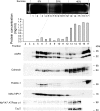


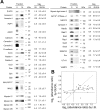
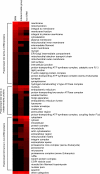
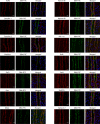

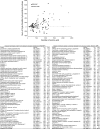

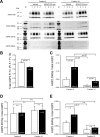

Similar articles
-
Identification of UT-A1- and AQP2-interacting proteins in rat inner medullary collecting duct.Am J Physiol Cell Physiol. 2018 Jan 1;314(1):C99-C117. doi: 10.1152/ajpcell.00082.2017. Epub 2017 Oct 18. Am J Physiol Cell Physiol. 2018. PMID: 29046292 Free PMC article.
-
Dynamics of aquaporin-2 serine-261 phosphorylation in response to short-term vasopressin treatment in collecting duct.Am J Physiol Renal Physiol. 2007 Feb;292(2):F691-700. doi: 10.1152/ajprenal.00284.2006. Epub 2006 Sep 19. Am J Physiol Renal Physiol. 2007. PMID: 16985212
-
High-throughput identification of IMCD proteins using LC-MS/MS.Physiol Genomics. 2006 Apr 13;25(2):263-76. doi: 10.1152/physiolgenomics.00214.2005. Epub 2006 Jan 31. Physiol Genomics. 2006. PMID: 16449382 Free PMC article.
-
Proteomic approaches for the study of cell signaling in the renal collecting duct.Contrib Nephrol. 2008;160:172-185. doi: 10.1159/000125981. Contrib Nephrol. 2008. PMID: 18401169 Review.
-
Isolation of nano-meso scale detergent resistant membrane that has properties expected of lipid 'rafts'.J Neurochem. 2011 Mar;116(5):671-7. doi: 10.1111/j.1471-4159.2010.07076.x. Epub 2011 Jan 12. J Neurochem. 2011. PMID: 21214574 Review.
Cited by
-
Dynamin2, clathrin, and lipid rafts mediate endocytosis of the apical Na/K/2Cl cotransporter NKCC2 in thick ascending limbs.J Biol Chem. 2012 Nov 2;287(45):37824-34. doi: 10.1074/jbc.M112.386425. Epub 2012 Sep 12. J Biol Chem. 2012. PMID: 22977238 Free PMC article.
-
Membrane rafts and caveolae in cardiovascular signaling.Curr Opin Nephrol Hypertens. 2009 Jan;18(1):50-6. doi: 10.1097/MNH.0b013e3283186f82. Curr Opin Nephrol Hypertens. 2009. PMID: 19077689 Free PMC article. Review.
-
Regulation of Transporters and Channels by Membrane-Trafficking Complexes in Epithelial Cells.Cold Spring Harb Perspect Biol. 2017 Nov 1;9(11):a027839. doi: 10.1101/cshperspect.a027839. Cold Spring Harb Perspect Biol. 2017. PMID: 28246186 Free PMC article. Review.
-
Quantitative apical membrane proteomics reveals vasopressin-induced actin dynamics in collecting duct cells.Proc Natl Acad Sci U S A. 2013 Oct 15;110(42):17119-24. doi: 10.1073/pnas.1309219110. Epub 2013 Oct 1. Proc Natl Acad Sci U S A. 2013. PMID: 24085853 Free PMC article.
-
Molecular mechanisms regulating aquaporin-2 in kidney collecting duct.Am J Physiol Renal Physiol. 2016 Dec 1;311(6):F1318-F1328. doi: 10.1152/ajprenal.00485.2016. Epub 2016 Oct 19. Am J Physiol Renal Physiol. 2016. PMID: 27760771 Free PMC article. Review.
References
-
- Beausoleil SA, Villen J, Gerber SA, Rush J, Gygi SP. A probability-based approach for high-throughput protein phosphorylation analysis and site localization. Nat Biotechnol 24: 1285–1292, 2006. - PubMed
-
- Brown D, Roth J, Orci L. Lectin-gold cytochemistry reveals intercalated cell heterogeneity along rat kidney collecting ducts. Am J Physiol Cell Physiol 248: C348–C356, 1985. - PubMed
-
- Brown DA Lipid rafts, detergent-resistant membranes, and raft targeting signals. Physiology (Bethesda) 21: 430–439, 2006. - PubMed
-
- Brown DA, Rose JK. Sorting of GPI-anchored proteins to glycolipid-enriched membrane subdomains during transport to the apical cell surface. Cell 68: 533–544, 1992. - PubMed
Publication types
MeSH terms
Substances
Grants and funding
LinkOut - more resources
Full Text Sources
Molecular Biology Databases

